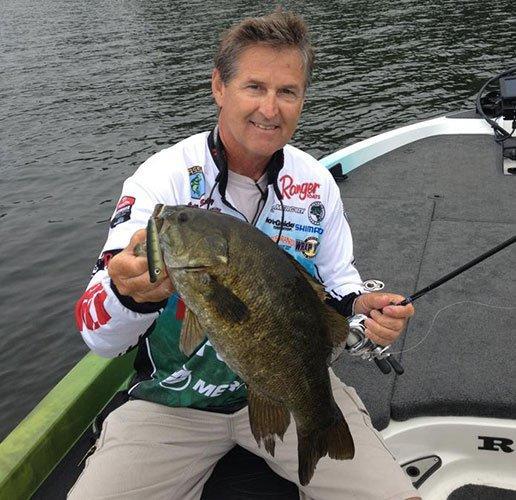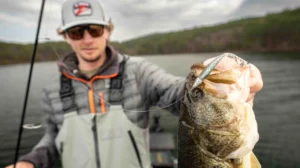Topwater fishing is some of the most fun a bass angler can possibly have. Whether you’re partial to walking baits, poppers, prop baits or buzz baits, it’s a great way to catch a lot of big bass that other anglers may leave behind.
Rapala pro Bernie Schultz has a great deal of confidence when it comes to topwater fishing for bass. While many anglers turn to crankbaits or spinnerbaits when the going gets tough, he unleashes his topwater repertoire to put big bass in the boat. According to Schultz, 5 simple tips will make you a more productive topwater angler.
1. Great topwater action can happen at any time
When most bass anglers think about topwater fishing, visions of sunrises and sunsets flood their minds. Although lowlight conditions are a bit more conducive to topwater action, Schultz doesn’t discriminate—he’s found outstanding topwater bites throughout all times of day.
“Topwater fishing is not just for lowlight hours,” Schultz said. “I think people really short themselves when they only throw topwater lures for an hour or two. Big fish become accustomed to seeing your typical hard baits swim in front of their faces and a topwater presentation will often catch those fish when other techniques fail. It’s always important to show them something they don’t see as much.”
As long as there’s 2 to 3 feet of water clarity, you can count on Schultz having an array of topwater baits within reach. Some of his most productive topwater fishing comes in high skies on vegetation-filled fisheries.
“In the south, there’s going to be a lot of vegetation that holds fish,” Schultz said. “Sure, the vegetation gives bass a great ambush point for feeding, but most importantly, it acts as a filter and results in clearer water. Anytime a bass can see a long distance, they’re more apt to eat a topwater bait.”
2. Become familiar with the best applications for each technique
Just as an automotive mechanic has a toolbox full of tools for specific applications, the same goes for Schultz’s topwater arsenal. Even though he’s narrowed down his selections for explicit scenarios, Schultz believes there is no cut-and-dry explanation. Time on the water is invaluable.
“Different topwater presentations work at different times, so there are no ‘absolutes’ in topwater fishing,” Schultz said. “If you spend enough time on the water, you’ll develop your own confidence and it’s no secret that confidence is everything in bass fishing.”
Schultz often begins his search for topwater bass with a Hildebrandt HeadBanger Buzzbait in order to cover water quickly and get a feel for current bass behavior. When targeting irregularities in grass beds and flooded brush, he may not always get a solid hookup, but any reaction gives away the bass’ location.
“If I miss a buzzbait fish, I like to throw a prop bait, such as a Rapala X-Rap Prop,” Schultz said. “Throwing just past the initial blowup, pulling it a couple of times and letting it sit still will draw a lot of awesome strikes.”
If his initial offerings fail to draw strikes and shad are present, he opts for a Rapala X-Rap Pop or a Rapala Skitter Pop. The slower the bite is, the longer he’ll let the lure sit between twitches. At times, he’s had to wait an entire 30 seconds before enticing a blowup.
“There is no lure on the market that will mimic the surface ‘flicking’ sound shad make better than the Skitter Pop,” Schultz said.
When he’s faced with ultra-clear reservoirs, Schultz generally prefers a walking topwater bait, such as a Rapala Skitter Walk. It’s an ideal approach for covering water over long points, stumps, flooded brush and blowdowns.
“The Skitter Walk has a single knocker on the inside, resulting in a very deep, resonating knocking sound that calls fish from long distances and heavy cover,” Schultz said. “I’ve caught big smallmouth on it in the Great Lakes and huge largemouth with it in submerged grass beds in Florida. It’s extremely versatile.”
3. Line selection is critical
Floating baits call for floating line, according to Schultz. To achieve the floating characteristics of monofilament and the low-stretch qualities of fluorocarbon, he uses Sufix Superior Copolymer Line.
“In my opinion, a great copolymer line gives you just the right amount of stretch for good action and enough forgiveness for treble hook presentations,” Schultz said. “Some guys like braided line, but I like a little more stretch in the line for additional shock absorption.”
His line size selection is relatively simple. For popping topwater baits, he uses 15-pound test and for everything else, he spools up with 17 to 20-pound test. There is one situation, however, in which Schultz will choose to use braided line.
“I definitely use braid when I’m fishing topwater frogs, or any other soft plastic bait on the surface,” Schultz said. “You need to be able to pop those fish right when they bite and bring them through thick cover, so I use 60-pound Sufix 832 Braided Line.”
4. Stay aware and remain patient
It happens to fishermen all the time—the minute you start aimlessly working a topwater bait and daydreaming about what could have been, a giant blows up on your lure. To avoid this, Schultz stresses the importance of staying focused and patient.
“If you’re not patient, topwater fishing may not be for you,” Schultz laughed. “You have to believe in it. Just like Denny Brauer flips for 5 big bites a day, sometimes you’ve got to do that with topwater fishing. There will be days you can throw a tennis shoe with a hook and catch a limit, but more times than not, it can be a bit of a grind.”
Timing is a big deal for topwater fishing. If you throw a topwater bait for an hour and don’t get bit, sometimes it pays to stick it out. The bass may just be in a feeding lull, but could fire up at a moment’s notice.
“The fish have to tell you what they want and it’s important to give them a chance to talk,” Schultz said. “To get confidence in topwater fishing, it’s important to get on the water and realize how quickly things can change in a matter of minutes.”
5. Give yourself plenty of options to fine-tune your approach
Topwater bass can be downright picky at times. When faced with obstinate bass, small variations in size and color can make all the difference in the world. These small differences are why Schultz carries multiple baits in difference sizes and colors. To simplify his color selection process, he primarily relies on chrome, gold and bream patterns.
“I always keep a couple of sizes of XPops, Skitter Walks and HeadBangers in my boat,” Schultz said. “Many times you’ll get a lot of blowups and only end up hooking a couple of them. Don’t take that as a sign that they simply don’t want to eat a topwater. Instead, change things up—whether it’s size, color or a slightly different cadence, it can all make a big difference”
Topwater fishing can be a hugely effective technique when you least expect it. This summer, try to go outside of your comfort zone and throw a few topwater baits when other anglers wouldn’t even consider it. Your fishing day might turn into a day you’ll never forget.













